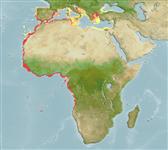Common names from other countries
Environment: milieu / climate zone / depth range / distribution range
Ecology
Marine; benthopelagic; oceanodromous (Ref. 51243); depth range ? - 170 m (Ref. 4781). Subtropical; 44°N - 16°S, 17°W - 35°E (Ref. 54696)
Eastern Atlantic: Portugal to Angola, including the southwestern Mediterranean, Madeira, and the Canary Islands.
Size / Weight / Age
Maturity: Lm ? range ? - ? cm
Max length : 80.0 cm SL male/unsexed; (Ref. 4781); common length : 30.0 cm SL male/unsexed; (Ref. 4781); max. published weight: 3.0 kg (Ref. 4699)
Adults Inhabit hard bottoms (rock or rubble); the young occur near the coast. Feed mainly on mollusks including cephalopods, and also on crustaceans (Ref. 3688). Important food fish.
Life cycle and mating behavior
Maturity | Reproduction | Spawning | Eggs | Fecundity | Larvae
Bauchot, M.-L. and J.-C. Hureau, 1990. Sparidae. p. 790-812. In J.C. Quero, J.C. Hureau, C. Karrer, A. Post and L. Saldanha (eds.) Check-list of the fishes of the eastern tropical Atlantic (CLOFETA). JNICT, Lisbon; SEI, Paris; and UNESCO, Paris. Vol. 2. (Ref. 3688)
IUCN Red List Status (Ref. 130435)
CITES (Ref. 128078)
Not Evaluated
Threat to humans
Harmless
Human uses
Fisheries: minor commercial; gamefish: yes; aquarium: commercial
More information
ReferencesAquacultureAquaculture profileStrainsGeneticsElectrophoresesHeritabilityDiseasesProcessingMass conversion
Tools
Special reports
Download XML
Internet sources
Estimates based on models
Preferred temperature (Ref.
115969): 14.3 - 27.5, mean 19 (based on 382 cells).
Phylogenetic diversity index (Ref.
82804): PD
50 = 0.5156 [Uniqueness, from 0.5 = low to 2.0 = high].
Bayesian length-weight: a=0.01622 (0.00906 - 0.02903), b=2.96 (2.81 - 3.11), in cm Total Length, based on LWR estimates for this species & (Sub)family-body (Ref.
93245).
Trophic level (Ref.
69278): 3.8 ±0.2 se; based on diet studies.
Resilience (Ref.
120179): Very Low, minimum population doubling time more than 14 years (Preliminary K or Fecundity.).
Fishing Vulnerability (Ref.
59153): High vulnerability (59 of 100).
Climate Vulnerability (Ref.
125649): Moderate vulnerability (43 of 100).
